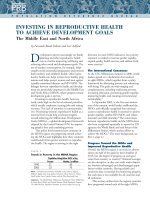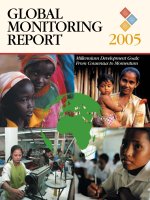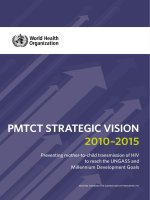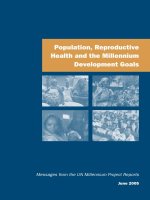The Costs of Attaining the Millennium Development Goals * ppt
Bạn đang xem bản rút gọn của tài liệu. Xem và tải ngay bản đầy đủ của tài liệu tại đây (44.07 KB, 9 trang )
The Costs of Attaining the Millennium Development Goals
*
Summary: Using two different approaches, the World Bank estimates that, if countries
improve their policies and institutions, the additional foreign aid required to reach the
Millennium Development Goals by 2015 is between $40-$60 billion a year. This estimate
is consistent with other agencies’ estimates of the costs of achieving individual goals,
such as those for education and health. By itself, this additional aid will not be sufficient
to attain the goals, as many countries will have to reform their policies and improve
service delivery to make the additional spending effective.
The World Bank’s approach to estimating the costs of attaining the Millennium
Development Goals (MDGs) is based on two findings from research and experience in
development. First, financial assistance is one of many inputs required to reach the goals.
In particular, given the weak links between public spending on, say, health and health
outcomes, overall policy reforms, and improvements in service delivery would be at least
as important as financial assistance. Second, foreign aid is effective in countries where
the policy and institutional environment is conducive to poverty reduction. Thus, if
additional financial assistance were available, it should be allocated to those countries
that have, or are developing policy and institutional environments in which foreign aid
will be effective. These two findings imply that we should be extremely careful in
interpreting the resource estimates of the cost of attaining the MDGs. The estimates
should not be taken as an amount of money which, if available, would guarantee that the
MDGs will be reached. Money is not the only input, or even the most important input. If
the aid goes to countries with poor policies and institutions, it is likely to be wasted. The
question we are asking, therefore, is the following: If the necessary changes in policies
and institutions are forthcoming, how much additional financial resources will be needed
to achieve the 2015 goals?
In that spirit, we approach the costs of reaching the MDGs through two routes.
In the first route, we focus exclusively on the first goal, namely, reducing income poverty
by half between 1990 and 2015. Inasmuch as income poverty is linked to the other
targets, such as infant mortality and primary enrolment, achieving this goal will go some
way towards achieving the others. The link is stronger the more the actions to promote
growth are associated with those to promote human development. If we estimated the
costs by adding the costs of achieving each of the goals independently, there would be
some double-counting. However, achieving the human-development-related goals will
require additional effort that goes substantially beyond what is required for the poverty
goal.
*
This paper summarizes the results of a World Bank Policy Research Working Paper, “Development
Goals: History, Prospects and Costs,” by Shantayanan Devarajan, Margaret J. Miller, and Eric V.
Swanson.
2
Millennium Development Goals (1990-2015)
1. Eradicate extreme poverty and hunger
• Halve the proportion of people with less than one dollar a
day.
• Halve the proportion of people who suffer from hunger.
2. Achieve universal primary education
• Ensure that boys and girls alike complete primary
schooling.
3. Promote gender equality and empower women
• Eliminate gender disparity at all levels of education.
4. Reduce child mortality
• Reduce by two thirds the under-five mortality rate.
5
. Improve maternal health
• Reduce by three quarters the maternal mortality ratio.
6. Combat HIV/AIDS, malaria and other diseases
• Reverse the spread of HIV/AIDS.
7. Ensure environmental sustainability
• Integrate sustainable development into country policies
and reverse loss of environmental resources.
• Halve the proportion of people without access to potable
water.
• Significantly improve the lives of at least 100 million
slum dwellers.
8. Develop a global partnership for development
• Raise official development assistance.
• Expand market access.
• Encourage debt sustainability.
In the second route, we take a
parallel track, and estimate the costs of
attaining the health, education and
environmental goals, noting that the
achievement of these goals will go a
long way towards reducing income
poverty. Both routes yield
approximately the same estimate for the
costs of reaching the MDGs, namely,
around $40 to $60 billion in addition
foreign aid. As we have argued, to
simply add these latter estimates to the
former which was focused on the
income poverty goal would involve
substantial double counting. At the
same time they are not alternative
estimates of what is necessary to reach
the complete set of goals. Nevertheless,
taking into account that we have to deal
with broad ranges for the estimates, the fact that the two estimates are similar gives some
reassurance. We would suggest that, given that some additionality is required, the upper
part of the $40-60 billion range is likely to be of greater relevance. We should note
however, that greater improvements in policy than those assumed, as well as
improvements in other policies by rich countries, such as those for trade, would work to
reduce the required resources. The estimate in the Zedillo report of the United Nations of
$50 billion in additional financing, embraced by UK Chancellor of the Exchequer
Gordon Brown, lies in the middle of this range.
The Poverty Goal: Reduce income poverty by half in 2015
Throughout this exercise, as well as in all the Bank’s work on the MDGs, we
interpret the goals as applying to each country, rather than only to the global population.
We estimate the additional aid required to reach the income poverty goal as follows.
First, we identify those countries that are either “on track” to reach this goal using
currently-available resources, or countries where additional aid will not make a big
difference, since foreign aid is so small compared to the size of their economy (labeled
“On Track” countries in Table 1). The remaining 65 countries, “uphill” countries, are the
potential recipients of this additional aid. Next, applying the second finding above, we
subdivide uphill countries into those with adequate policies and institutions, and those
without. Such classification and the related cutoff are always a matter of judgment. We
use a composite performance indicator to distinguish between countries with adequate
policies that can make effective use of additional funds immediately, and those with less
satisfactory policies that would have to be improved if the funds were to be used
effectively. This leaves 43 of the uphill countries that could effectively absorb more aid
3
today, and 22 that would need to improve their policies and institutions before they could
benefit from additional aid
1
.
The third step is to estimate, for the 43 uphill countries with adequate policies, the
additional aid required to reach the poverty goal. We employ a very simple method:
first, we calculate the GDP growth rate required to achieve the necessary reduction in
poverty
2
; then we calculate the investment required to achieve this GDP growth rate;
finally, we calculate the additional aid (given domestic savings rates) required to finance
this investment
3
. This procedure yields an estimate of an additional $39 billion per year
required for these countries to reach the income poverty goal.
For the remaining 22 countries, we assume that additional aid would be
forthcoming only if they improve their policies and institutions. If these countries are
able to bring their policies and institutions up to the average of the better-performing
countries, then an additional $15 billion per year would be needed to assist these
countries in reaching the poverty goal
4
. Thus the additional aid ranges from $39 billion
to $54 billion depending on whether the worse performers do not or do improve their
policies. If they do not, then the income poverty goal will not be achieved in those
countries. The upper end of this range represents an approximate doubling of current
levels of ODA ($57 billion in 1999)
5
.
Table 1: Additional aid levels required to halve income poverty
1
Clearly, this dichotomy oversimplifies, but the key point is that the use of additional aid to reach the goal
will depend on the quality of policies and institutions. Using other classifications of policies does not
change the broad numbers very much.
2
This calculation assumes that the distribution of income in the country remains unchanged for the fifteen-
year period. Experience shows that (pre-tax-and-transfer) distributions of income generally change quite
slowly. Inequality varies substantially across countries, however, and this variation is reflected in the
different growth-poverty elasticities across countries. That is, a high-inequality country will generally
require more growth to achieve the same poverty reduction as a low-inequality country.
3
This procedure does not distinguish between private and public investment. If these countries are
successful in improving their investment climate, the amount of additional foreign aid needed will
decrease. First, such an improvement would work to increase private investment which, in terms of
growth, can substitute for aid. Second, the overall productivity of capital in the economy will increase,
reducing the amount of additional investment (and hence foreign aid) needed to generate the same growth
rate. Note we are presenting the analysis explicitly here in a way which allows for potential improvements
in the policy environment and productivity of the economy.
4
We assume that it will take about five to seven years for these countries to bring their policies and
institutions up to the average of the better-performing countries.
5
Like all model-based estimates, our results depend on the assumptions. In particular, the estimates
depend on productivity of capital (expressed in terms of the incremental capital-output ratio, or ICOR) in
each country. While we used historical evidence to calibrate this parameter, sensitivity analysis reveals that
the additional aid required to meet the income poverty goal could be different if the ICORs were higher or
lower. For example, if all countries had an ICOR that was one standard deviation above the mean, the
additional aid required would be $115 billion; if they had an ICOR one standard deviation below the mean,
the additional aid required would be $12 billion. While neither of these figures is realistic, they remind us
of the fact that the calculations in this paper should be treated as representing a range rather than precise
point-estimates. And we should recognize that reducing ICORs is generally associated with improving
(deteriorating) economic policies.
4
Current ODA
levels
1999
($ billions)
Additional
ODA
required
“On Track” countries 33
“Uphill” countries 24 54
Adequate policies and institutions 19 39
Weak policies and institutions 5 15*
Official development assistance 57 54*
Total aid (% of high-income OECD GNP) 0.25 0.49
*assuming improved policies and institutions
There is an analogy between the two scenarios presented here and the HIPC
initiative. The HIPC initiative pledged to reduce the debt to all low-income countries,
estimated the total cost of this debt-reduction, but then made access to debt-reduction
conditional on an adequate policy and institutional framework (as reflected in the Poverty
Reduction Strategy Paper). To reach the MDGs, similarly, we calculate that as much as
an additional $54 billion would be needed, but access to this financing should also be
conditional on adequate policies and institutions. Until the poor-performing countries
improve their policies and institutions, the additional cost will be only $39 billion,
although in this case the goal would not be reached for all countries. While the other 33
“on track” countries are likely to meet the goals, substantial inroads into poverty in these
countries would flow from an increase in their aid to GDP ratios.
These calculations assume that, with the exception of foreign aid, all other
international exchanges continue as “business as usual.” Specifically, we assume that
private capital flows, already quite small in these countries, will not increase as a share of
GDP. If instead private capital flows increased by one percentage point faster than GDP,
the difference in the aid requirement would be negligible. If private capital flows in the
weak-policy countries rose to the average of those with adequate policies, the additional
aid required to meet the income poverty goal would be reduced by $0.5 billion.
We also assume that the world trading system will remain essentially
unchanged—becoming neither more protectionist nor more open. If the Doha summit
produces tangible results, they should include providing greater market access for
developing countries. For developing countries as a group, the benefits of this increased
market access will be much larger than financial transfers through official development
assistance over the period to 2015. Unfortunately, these gains would not substitute for
development assistance in helping all countries reach the MDGs. The reason is two-fold.
First, Africa plays such a small part in world trade (and already has preferential access in
certain areas) that the geographic distribution of trade-related benefits favors the high-
trading, lower and middle-income countries. A general-equilibrium-model simulation of
reducing protection by half worldwide yields a welfare gain in 2015 of about $200 billion
for developing countries as a whole. But only $2.4 billion of that accrues to Sub-Saharan
Africa, and another $3.3 billion in South Asia outside India. While small, these gains are
5
not trivial: when combined with the price changes and distributional effects of trade
reforms, they would lift an additional 10 percent of Africans out of poverty
6
.
Secondly, these low-income countries are too poor to benefit fully from
multilateral trade liberalization without aid. To take advantage of market access, they
require hefty investments in trade-creating infrastructure, transportation, and
telecommunications, as well as investments in trade-related government institutions, such
as better customs and tax administration, and overall management of public investment.
These in turn require development assistance—“aid for trade”. In short, even though it
will undoubtedly benefit developing countries by stimulating growth and reducing global
poverty, reducing trade barriers is not sufficient to eliminate the need for aid in those
countries with the largest income-poverty MDG gap.
Finally, there is the question of whether this $39 - $54 billion in aid, even if
accompanied by improvements in policies and institutions, would strain the “absorptive
capacity” of recipient countries. There are different ways to look at absorptive capacity.
One way is to examine whether there are diminishing returns to aid. One piece of recent
research on the growth impact of additional aid calculates that, for countries which have
policies and institutions that are among the best of developing countries, a “saturation
point”—the point beyond which the growth impact is zero—is reached when aid is
around 30 percent of GDP. By contrast, the saturation point for countries with extremely
weak policies and institutions is calculated to be around 6 percent of GDP. Applying
these estimates to our estimates, we find that for four of the uphill countries with
adequate policies the saturation point would be reached. On average, the additional aid
will leave the uphill countries with aid-to-GDP levels that are 35 percent of their
saturation point. In short, for most uphill countries with adequate policies, absorptive
capacity is unlikely to be a problem.
To be sure, these estimates may understate the effect of the absorptive capacity
constraint. If there are diminishing returns to aid throughout, the amount of additional
aid required to meet the income poverty goal would be higher. However, improvements
in donor policies could mitigate this effect. Much of the diminishing returns to aid is the
result of congestion effects—too many projects absorbing the limited technical and
managerial talent in developing countries. A shift by donors towards simplified and
harmonized aid modalities could therefore be an important element in reaching the goals.
We emphasize that we are working to achieve the MDGs country-by-country.
This strategy is different from an aid allocation scheme designed to maximize global
poverty reduction.
The Education, Health and Environment Goals
6
This is not enough to offset the increase in population growth, so the number of people living in poverty
in Africa would still rise during the period.
6
As mentioned earlier, we approach the costing exercise using two routes. The
first route was to estimate the cost of attaining the poverty goal, recognizing that by
reducing poverty, we would also be making substantial progress towards the other goals.
In the second route, we put to one side the income poverty goal, and estimate the costs of
attaining the health, education and environmental goals, but note that the achievement of
these goals will go a long way towards reducing income poverty. We calculate the costs
of each of these goals individually. They are closely connected, however, and advances
in one will, over time, benefit the other.
Education goal: Universal primary education by 2015
The additional costs of achieving universal primary education by 2015 can be
inferred by examining the average (per-pupil) costs of primary education today, and
multiplying this cost by the number of primary school-age children not in school. Since
this unit cost varies substantially across regions (and across countries within regions), the
resulting global estimate varies between $10 billion and $15 billion, depending on
whether regional, national or global averages are used. These figures are also close to
those obtained by UNICEF in their “minimum global estimate” of $9.1 billion. There is
also a suggestion that an international norm of 13 percent of GDP per capita be used as
the expenditure on each primary school student. This yields an overall cost of $28
billion, a relatively high estimate.
These estimates represent the sustaining cost of children already in school; they
do not necessarily reflect the additional cost required to enroll a child in school. The
latter will vary across countries even more than average cost. To help assess these
additional costs, we calculate the costs, given some of the complementary policies
(including demand-side interventions and increased domestic financing) required to
increase enrollment in four Sahelian countries. These calculations yielded an incremental
cost of $62 per student, which is close to the sustaining costs in Africa and South Asia. If
we extrapolate from these country studies to the population at large in Africa and South
Asia, and apply appropriate multipliers to other regions, the implied incremental cost
would also be about $10 - $15 billion. This estimate is, of course, not the final word.
Currently on-going work aims to calculate the additional cost in all countries that are at
risk of not meeting the education goal. Nevertheless, using different methods (average
sustaining cost, incremental reform costs, and norms), and taking into account the
uncertainty in each of these estimates, we conclude that the annual cost of achieving the
education goal will be at least $10 billion and possibly as high as $30 billion.
It is important to note that these estimates are based on the notion that the
additional education aid goes to countries that have undertaken the policy reforms
associated with increasing primary enrollment. While this may be a different set of
countries from those with an adequate overall policy environment, this estimate is
consistent in spirit with that for reaching the income poverty goal, namely, that additional
aid is predicated on there being a policy and institutional environment where the aid is
effective.
7
Health goal: Reduce infant mortality by two-thirds by 2015
For the health goals, we can identify specific inputs that contribute to reduction in
infant mortality, say, and then estimate the costs of delivering these inputs. For instance,
oral rehydration therapy, vaccinations, and promotion of breast feeding have all been
shown to reduce infant mortality. Similarly, for the goal of reducing infectious diseases,
there are specific interventions, such as insecticide-treated bednets for malaria, and the
DOTS strategy for tuberculosis, for which unit cost estimates exist. Applying these unit
costs to the treatment population could lead to both an over- and an under-estimate of the
costs of reaching the health goals. It could be an over-estimate because the diseases are
inter-related: tuberculosis spreads much more rapidly in the presence of AIDS; AIDS has
an impact on infant and maternal mortality; and malaria kills a large number of young
children. At the same time, it could be an under-estimate because of the many “weak
links in the chain” going from public health spending to health outcomes. Given the
possibility of both an over-estimate and an under-estimate, the overall estimate using this
approach may not be far off. In any event, we calculate it to be between $20 and $25
billion per year for all the health-related goals. Again, these unit cost estimates only
apply when the policy and institutional environment is conducive to additional health
spending being effective. Also, as noted earlier, other factors contribute to health
outcomes. In particular, women’s sanitation and safe water have been found to influence
infant mortality strongly. To the extent that countries make progress on these
dimensions, that amount of additional resources needed for health interventions will be
lower.
Another estimate of a related goal is that proposed by the Commission on
Macroeconomics and Health of the WHO. Their overall estimate of an additional $22
billion in foreign aid lies within this range. It too was calculated by estimating the unit
costs of the specific interventions required to reduce avoidable deaths (around $30 - $40
per person per year), and assuming an increase in the national budgetary contribution to
health by about 1.5 percent of GDP. Inasmuch as the Commission considered a broader
set of health problems than those in the MDGs, the two estimates are not completely
comparable. Nevertheless, given the similarity in approaches, it is not surprising that
they arrived at similar numbers.
Environment goal: Universal access to water and sanitation by 2015
We estimate the costs of achieving the environment goals (essentially water and
sanitation) by looking at a range of estimates, one for achieving universal coverage ($30
billion a year), another for reaching basic levels of coverage ($9 billion). These estimates
should be approached cautiously, because there are some who believe that enough
resources exist to achieve universal access to water supply—it is just the institutional
arrangements that prevent it from being achieved. Similarly, some of the improvements
in access to sanitation are likely to be achieved through the implementation of policies in
the pursuit of the health goal of reducing infant mortality. Finally, the “City without
Slums” program has estimated the cost of providing secure land tenure and upgrading
8
slums to be $3.5 billion annually. Taking these estimates and their caveats together, we
estimate that the cost of reaching the environment goal is between $5 and $21 billion.
The above three estimates yield a rough breakdown of the additional costs of
achieving the social goals as follows:
Education $10 - $30 billion
Health: $20 - $25 billion
Environment $ 5 - $21 billion
Total: $35 - $76 billion
Thus, the second route of calculating the additional costs of reaching the MDGs
leads to a range of estimates that encompasses those from the first route (the cost of
reaching the poverty goal only was $39 - $54 billion). Especially since the second route
was roughly consistent with estimates for individual goals obtained by other agencies
(UNICEF and WHO in particular), we conclude that a global estimate of the additional
aid required to attain the MDGs is somewhere between $40 billion and $60 billion a year.
While we have taken the two sets of estimates as alternative ways of costing the
MDGs, we should note that they are not wholly substitutable. Since the contribution of
growth to reducing infant mortality and increasing primary enrolment, while statistically
significant is also numerically small, the overall estimate of the costs of achieving the
MDGs is probably near the upper end of the range. At the same time, improvements in
policies and advances in market access could take us to the middle of the range.
Furthermore, lest we read too much into the fact that these two approaches
yielded roughly similar estimates, it should be noted that they represent somewhat
different perspectives on the process of achieving the goals. The first approach considers
economic growth as the main driver, and estimates the additional costs by calculating the
additional savings required to finance the investment that will lead to the desired income
growth. The second approach looks at the specific interventions required to achieve the
goals of education, health and the environment. To the extent that improvements in
education, health and the environment lead to faster economic growth—and there is
substantial evidence that they will—the second approach can also be associated with a
growth-driven strategy to achieve the goals. Similarly, the additional growth in the first
approach increases public resources that could, and will, be spent on education, health
and environmental interventions such as those in the second approach. Thus, the ultimate
differences between the two approaches may not be so great, but the fact that they start
from different premises should not be overlooked.
Finally, we must reiterate the point made at the beginning, namely, that additional
financing is one of many inputs required to reach the MDGs. Money alone will not
guarantee that we will reach the goals. Policies and institutions are fundamental to
9
progress on poverty reduction in all its dimensions. When countries have the appropriate
policies and institutional arrangements that will make additional aid effective, then
money can play an important if not critical role in accelerating progress towards the
goals. What is needed to realize this international commitment is for all members of the
global community to accelerate their efforts: for the 22 or so uphill countries to improve
their policies and institutions; for the developed countries to relax trade barriers and
better coordinate aid; and for donors to increase financial aid by about $40 - $60 billion
annually.









